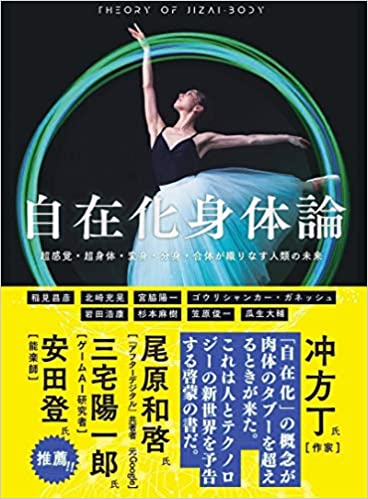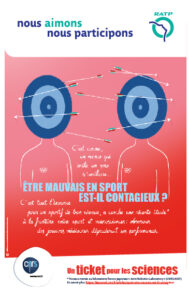Book Chapters
- M. Inami, G. Ganesh, Y. Miyawaki, M. Kitazaki, Y. Iwata, M Sugimoto. ⾃在化⾝体論:超感覚・超⾝体・変⾝・分⾝・合体が織りなす⼈-類の未来 (Freedom from body constraints: Extrasensory, superhuman, variational, split, and coalesced people -as the future of mankind).
NTS Publications, Tokyo.
- E. Burdet, G. Ganesh, C.G. Yang, A. Albu-Schäffer.
Interaction Force, Impedance and Trajectory Adaptation: by Humans, for Robots.
Springer Tracts in Advanced Robotics.
- E. Burdet, R. Gassert, G. Gowrishankar, D. Chapuis, H. Bleuler.
fMRI Compatible Haptic Interfaces to Investigate Human Motor Control.
Springer Tracts in Advanced Robotics, Springer 25-34.
Articles in Peer Reviewed Journals and Conferences (* indicates equal contribution)
- A. Takagi, C. Bagnato, A. Melendez-Calderon, N. Jarrasse, G. Ganesh, E. Burdet (2023). Competition increases the effort put into a physical interaction task. IEEE Trans Haptics. 2023. doi: 10.1109/TOH.2023.3306794.
- N. Nishida, Y. Iwasaki, G. Ganesh, H. Iwata (2022). A Study towards Embodied Supernumerary Limbs- Effects of Embodiment Induction on Reducing Attention Demand and Improving Performance Poster at the IROS XR and Robotics Workshop. Best Poster Award.
- KP. Tee, S. Cheong, J. Li, G. Ganesh (2022).
A Framework for tool cognition in robots without prior tool learning or observation. Nature Mach Intell 4, 533–543 (2022). https://doi.org/10.1038/s42256-022-00500-9. Preprint on Hal.
- G. Ganesh, Y. Miyawaki (2021).
ロボットは我々の身体の一部になりえるのか?Can we perceive robots as parts of our body?
Japanese Journal of Robotics and Mechatronics, 39(8):693-700. https://doi.org/10.7210/jrsj.39.693
- N. Yoshimura, K. Umetsu, A. Tonin, Y. Maruyama, K. Harada, A. Rana, G. Ganesh, U. Chaudhary, Y. Koike, N. Birbaumer (2021).
Binary semantic classification using cortical activation with Pavlovian- conditioned vestibular responses in healthy and locked-in individuals,
Cerebral Cortex Communications. tgab046, https://doi.org/10.1093/texcom/tgab046
- G. Gourmelen, B. Navarro, A. Cherubini, G. Ganesh (2021).
Human guided trajectory and impedance adaptation for tele−operated physical assistance.
IEEE International conference on intelligent robots and systems, IROS 2021. Preprint on hal−03001342t.
- Y. Shi, G. Ganesh, H. Ando, Y. Koike, E. Yoshida, N. Yoshimura (2021).
Decoding motor imagery based on prediction errors and channel optimization.
International Journal of Neural Systems. 31(11):2150034. doi: 10.1142/S0129065721500349.
- K. Sakurada, G. Ganesh, W. Yu (2021).
A novel tactile feedback system with online texture decoding and direct−texture−feedback.
IEEE International Conference on Robotics and Automation, ICRA 2018. Preprint on hal−03042579t.
- A. Maekawa, S. Kasahara, H. Saito, D. Uriu, G. Ganesh, M. Inami (2020).
That tight game: implicit force intervention in inter-personal physical interactions on playing tug of war.
IEEE ACM SIGGRAPH 2020 Emerging Technologies. https://doi.org/10.1145/3388534.3407301
- D. Heraiz-Bekkis, G. Ganesh, E. Yoshida, N, Yamanobe (2020).
Robot movement uncertainty determines human discomfort in co-worker scenarios.
IEEE International Conference on International Conference on Control, Automation and Robotics, ICCAR 2020, Singapore, April 2020.
- G. Gourmelen, A. Verhulst, T. Sasaki, B. Navarro, G. Ganesh, M. Inami (2019).
Co-Limbs: An Intuitive Collaborative Control for Wearable Robotic Arms.
The 12th ACM SIGGRAPH Conference and Exhibition on Computer Graphics & interactive Techniques in Asia, Brisbane, November 2019.
- Z. Abderrahmane, G. Ganesh, A. Crosnier, A. Cherubini (2019).
A Deep Learning Framework for Tactile Recognition of Known as well as Novel Objects.
IEEE Trans. Industrial Informatics. doi: 10.1109/TII.2019.2898264
- Y. Li*, G. Ganesh*, N. Jarrassé*, S. Haddadin, A. Albu-Schäffer, E. Burdet (2018).
Force, Impedance and Trajectory Learning for Contact Tooling and Haptic Identification.
IEEE Transactions on Robotics. 34 (5):1170 – 1182.
- A. Vasalya, G. Ganesh, A. Kheddar (2018).
More than just co-workers: Presence of humanoid robot co-worker influences human performance.
PLOS ONE. https://doi.org/10.1371/journal.pone.0206698.
- K. Sakurada, G. Ganesh, W. Yu, K. Kita (2018).
Accurate decoding of material textures using a finger mounted accelerometer.
IEEE International Conference on Robotics and Biomimetics, IEEE ROBIO 2018.
- Z. Abderrahmane, G. Ganesh, A. Crosnier, A. Cherubini (2018).
Visuo-Tactile Recognition of Daily-Life Objects Never Seen or Touched Before.
International Conference on Control, Automation, Robotics and Vision, ICARCV 2018.
- A. Vasalya, G. Ganesh, A. Kheddar (2018).
Distinct motor contagions during and after observation of actions by a humanoid co-worker.
IEEE International Conference on Robot and Man, ROMAN 2018.
- K.P. Tee, J. Li, L.T.P. Chen, K.W. Wan, G. Ganesh (2018).
Towards Emergence of Tool Use in Robots: Automatic Tool Recognition and Use without Prior Tool Learning.
IEEE International Conference on Robotics and Automation, ICRA 2018.
- S. Kato, N. Yamanobe, G. Venture, G. Ganesh (2018).
Humans can predict where their partner would make a handover.
‘Late breaking report’ at the International Conference on Human Robot Interaction, HRI 2018.
- G. Ganesh, K. Nakamura,S. Saetia,AM. Tobar,E. Yoshida,H. Ando,N. Yoshimura,Y. Koike (2018).
Utilizing sensory prediction errors for movement intention decoding: a new methodology.
Science Advances Vol. 4, no. 5, eaaq0183 DOI: 10.1126/sciadv.aaq0183
- Z. Abderrahmane, G. Ganesh, A. Crosnier, A. Cherubini (2018).
Haptic Zero-Shot Learning: Recognition of Objects Never Touched Before.
Robotics and Autonomous Systems, 105-11:25.
- L. Aymerich-Franch, D. Petit, G. Ganesh, A. Kheddar (2017).
Object touch by a humanoid robot avatar induces haptic sensation in the real hand.
Journal of Computer Mediated Communication. 22(4):215:230.
- A. Takagi*, G. Ganesh*,T. Yoshioka, M. Kawato, E. Burdet (2017).
Physically interacting individuals estimate the partner’s goal to enhance their movements.
Nature Human Behavior. doi:10.1038/s41562-017-0054. {press pick up by CNRS Journal}
- J. Vogel, N. Takemura, H. Hoeppner, P. van der Smagt, G. Ganesh (2017).
Hitting the sweet spot: Automatic optimization of energy transfer during tool held hits.
IEEE International Conference on Robotics and Automation, ICRA 2017.
- L. Aymerich-Franch, D. Petit, G. Ganesh, A. Kheddar (2017).
Touch by an embodied humanoid robot induces haptic sensation from vision alone.
Journal of Computer mediated Communication, 22 (2017) 215–230.
- Aymerich-Franch, D. Petit, A. Kheddar, G. Ganesh (2016).
In a robot’s body: Illusory bi-location of the self during artificial body reduplication.
International Communication Association Annual Conference 2016.
- L. Aymerich-Franch, D. Petit, G. Ganesh, A. Kheddar (2015).
Embodiment of a humanoid robot avatar is preserved during partial and delayed control.
IEEE International Workshop on Advanced Robotics and its Social Impacts, ARSO 2015
- T. Pistohl, D. Joshi, G. Ganesh, A. Jackson K. Nazarpour (2014).
Artificial Proprioceptive Feedback for Myoelectric Prosthesis Control.
IEEE Transactions on Neural Systems & Rehabilitation Engineering. 23(3):498-507.
- B. Vanderborght, A. Albu-Schaeffer, A. Bicchi, E. Burdet, D. Caldwell, R. Carloni, M. Catalano, G.Ganesh, M. Garabini, G. Grioli, S. Haddadin, A. Jafari, M. Laffranchi, D. Lefeber, F. Petit, S. Stramigioli, N. Tsagarakis, M. Van Damme, R. Van Ham, L. Visser, S. Wolf (2013).
Variable Impedance Actuators: a Review.
Elsevier Robotics and Autonomous systems. 61(12):1601-1614.
- T. Pistohl, A. Jackson, G. Ganesh, D. Joshi, K. Nazarpour (2013).
Artificial Proprioception for Myoelectric Control.
IEEE Engineering in Medicine and Biology Conference EMBC, 2013.
- Vanderborght, A. Albu-Schaeffer, A. Bicchi, E. Burdet, D. Caldwell, R. Carloni, M. Catalano, G.Ganesh, M. Garabini, G. Grioli, S. Haddadin, A. Jafari, M. Laffranchi, D. Lefeber, F. Petit, S. Stramigioli, N. Tsagarakis, M. Van Damme, R. Van Ham, L. Visser, S. Wolf (2012).
Variable Impedance Actuators: Moving the Robots of Tomorrow.
Video at IEEE International conference on intelligent robots and systems, IROS 2012. {Best video award}
- G. Ganesh, N. Jarrasse, S. Hadaddin, A. Albu-Schaeffer, E. Burdet (2012).
A Versatile Biomimetic Controller for contact tooling and haptic exploration.
IEEE International Conference on Robotics and Automation, ICRA 2012.
- CG. Yang*, G. Ganesh*, S. Haddadin, S. Perusal, A. Albu-Schäffer, E. Burdet (2011).
Human-like adaptation of force and impedance in stable and unstable Interactions.
IEEE Transaction on Robotics. 99: 1-13. {Best Paper in 2011 award}
- Melendez-Calderon, V. Komisar, G. Ganesh, E. Burdet (2011).
Classification of strategies for disturbance attenuation in human-human collaborative tasks.
IEEE Engineering in Medicine and Biology Conference EMBC, 2011.
- G. Ganesh, A. Albu-Schäffer, M. Haruno, M. Kawato, E. Burdet (2011).
Force, Impedance and Trajectory Adaptation: by Humans, for Robots.
Invited poster at GCOE Cognitive Neuroscience Robotics, May 2011.
- E. Su, G. Ganesh, CF. Yeong, CL. Teo, WT. Ang, E. Burdet (2011).
Effect of grip force and training in unstable dynamics on micromanipulation accuracy.
IEEE Transactions on Haptics 4(3): 167-74.
- Malendez-Calderon, V. Komisar, G. Ganesh, E. Burdet (2011).
Mechanisms of collaboration in human-human interactive tasks.
Poster at Neural Control of Movement, NCM, April 2011.
- E. Burdet, G. Ganesh, C.G. Yang, A. Albu-Schäffer (2010).
Interaction Force, Impedance and Trajectory Adaptation: by Humans, for Robots.
International Symposium for Experimental Robotics, ISER, 2010.
- T. Lemmin*, G. Ganesh*, R. Gassert, E. Burdet, M. Kawato, M. Haruno (2010).
Model based attenuation of movement artifacts in fMRI.
J. Neuroscience Methods. 192(1): 58-69.
- G. Ganesh, A. Albu-Schäffer, M. Haruno, M. Kawato, E. Burdet (2010).
Biomimetic motor behavior for simultaneous adaptation of force, impedance and trajectory in interaction tasks.
IEEE International Conference on Robotics and Automation, ICRA 2010.
- E. Su, G. Ganesh, C. F. Yeong, E. Burdet (2010).
Accurate Micromanipulation induced by Performing in Unstable Dynamics. IEEE International Symposium on Robotics and human Interactive Communication, RO-MAN, 2010.
- G. Ganesh, D. Franklin, R. Gassert, H. Imamizu, M. Kawato (2007).
Accurate online feedback of surface EMG measurements during fMRI.
J. Neurophysiology. 97: 912-20.
- Chapuis, R. Gassert, G. Ganesh, E. Burdet, H. Bleuler (2006).
Investigation of a cable transmission for the actuation of MR compatible haptic interfaces.
IEEE / RAS-EMBS International Conference on Biomedical Robotics and Biomechatronics, BioRob 2006.
- R. Gassert, L. Dovat, G. Ganesh, E. Burdet, H. Bleuler (2006).
A 2-DOF fMRI compatible haptic interface to investigate the neural control of arm movements.
IEEE International Conference on Robotics and Automation ICRA, 2006.
- Dovat, R. Gassert, D. Chapuis, G. Ganesh, E. Burdet, H. Bleuler (2005).
A haptic interface based on potential mechanical energy to investigate human motor control using fMRI.
IEEE Engineering in Medicine and Biology Conference EMBC,2005
- R. Gassert, L. Dovat, G. Ganesh, E. Burdet, H. Imamizu, H. Bleuler (2005).
Multi-Joint arm movements to investigate motor control with fMRI.
IEEE Engineering in Medicine and Biology Conference EMBC, 2005.
- E. Burdet, R. Gassert, G.Ganesh, D. Chapuis, H. Bleuler (2004).
fMRI compatible haptic interfaces to investigate human motor control.
International Symposium on Experimental Robotics, ISER 2004.
- G. Ganesh, R. Gassert, H. Bleuler, and E (2004).
Dynamics and control of an mri compatible master-slave system with hydrostatic transmission.
IEEE International Conference on Robotics and Automation ICRA 04, pages 1288–1294, 2004.








